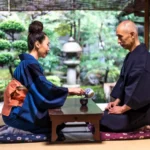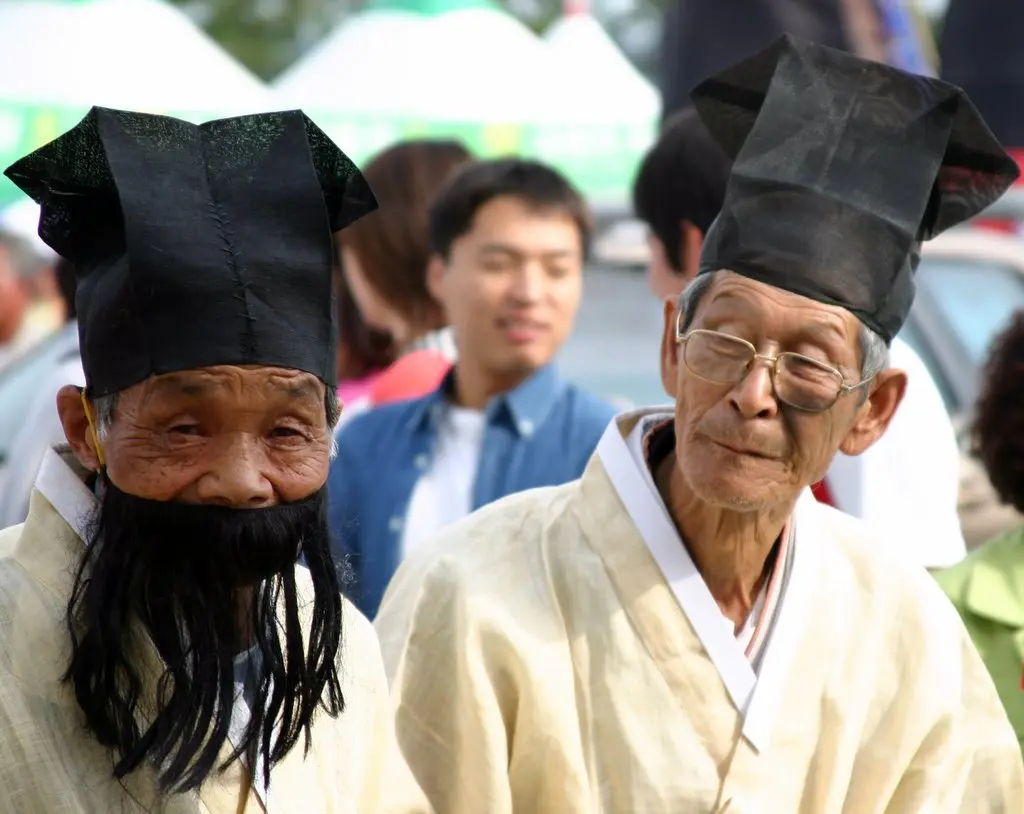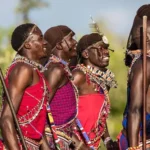The Hanbok, Korea’s traditional attire, is more than just clothing. It’s a cultural emblem deeply interwoven with the nation’s history, values, and customs. While the Hanbok is recognized globally for its vibrant colors and flowing lines, its significance extends far beyond everyday wear.
This article will explore the critical role the Hanbok plays in Jesa, Korean ancestral rituals, shedding light on the traditions and meanings associated with this beautiful garment during these solemn ceremonies.

Understanding Jesa: Honoring Ancestors
Jesa (제사) is a Korean ancestral rite that serves as a profound expression of respect and remembrance for deceased family members. These ceremonies are not simply about mourning; they are a continuation of the family bond, acknowledging the enduring influence of ancestors on current generations.
Jesa is rooted in Confucian values that emphasize filial piety and ancestor veneration. These rituals are carefully structured, involving specific food offerings, prayers, and gestures, all performed according to established traditions. The ceremony is usually held on significant dates, such as the anniversary of an ancestor’s death or during major holidays like Chuseok (Korean Thanksgiving) and Lunar New Year.
See also The Kimono in Japanese Tea Ceremonies and Festivals
The Kimono in Japanese Tea Ceremonies and FestivalsThe Importance of Respect in Jesa
Respect, or “gyeong“, is paramount in Jesa. Every aspect of the ceremony, from the preparation of the altar to the manner in which the participants conduct themselves, reflects this profound sense of reverence. Participants are expected to act with solemnity and humility, demonstrating their understanding of the solemn nature of the ritual.
The clothing worn during Jesa is another manifestation of respect for the ancestors and is crucial to creating the right atmosphere. This is where the Hanbok assumes a very important role.

The Hanbok: More Than Just Attire
The Hanbok is composed of several key pieces, each with its own significance. For women, the attire generally consists of a jeogori (a short jacket), a chima (a full, high-waisted skirt), and sometimes an overcoat or a durumagi.
Men typically wear a jeogori and baji (loose-fitting pants), often paired with a magoja (a type of outer jacket) or a durumagi. The design, colors, and materials of the Hanbok are not just for aesthetic purposes but can also signify the wearer’s age, status, and the occasion.
See also The Maasai Shúkà: A Key Element in Rites of Passage Ceremonies
The Maasai Shúkà: A Key Element in Rites of Passage CeremoniesHanbok Colors and Materials: A Language of Meaning
The colors and materials of the Hanbok are not chosen at random; they carry symbolic weight. Traditionally, natural dyes were used, resulting in earthy tones and softer shades. During Jesa, subdued colors such as white, off-white, grey and navy are predominantly chosen.
White represents purity, reverence and mourning, and this color is often worn during Jesa ceremonies. Black, also associated with mourning in many cultures, can be used on occasion too.
Bright, vibrant colours are generally avoided during these ceremonies to reflect the somber and respectful atmosphere. The fabric is also important. High-quality, natural fabrics like silk or cotton are often preferred for formal occasions, including Jesa.
The Hanbok in Jesa: Respect Embodied
During Jesa, the choice of Hanbok isn’t about fashion; it’s about demonstrating respect and sincerity towards the deceased. The clothing is not just a costume, it’s an integral part of the ritual, helping to set the tone and create an environment of reverence. The act of wearing the appropriate Hanbok is a way for participants to show they understand the seriousness of the occasion and are committed to honoring their ancestors properly.
Appropriate Hanbok Styles for Jesa
While specific styles can vary depending on regional customs and family traditions, there are general guidelines for Hanbok worn during Jesa:
- For Men: Men will often wear a plain white or light-colored jeogori with dark baji. A magoja or durumagi in a dark or muted color might also be worn as an outer layer. The key is to keep the colors subtle and avoid bright, eye-catching patterns.
- For Women: Women will wear a white or light-colored jeogori, often in cotton, with a dark-colored chima, typically navy blue, grey, or black. The focus remains on muted and respectful tones. The material of the Hanbok may be chosen to reflect the formality of the occasion, and silk may be selected over other more casual fabrics.
- For Both: Regardless of gender, the garments should be clean, well-maintained, and free from any extravagant embellishments. The focus is on humility and respect, not personal adornment. Jewelry is typically kept to a minimum.
The Ritual of Dressing for Jesa
The act of preparing for Jesa, which includes choosing and wearing the appropriate Hanbok, is an essential part of the ceremony. It is a moment of reflection and preparation. Families take great care in ensuring that the Hanbok is in good condition, often meticulously ironing and caring for it before the event.
The simple act of putting on these clothes reinforces the participant’s focus on the purpose of the ceremony. It’s not just about putting on a garment; it’s about embodying the spirit of the occasion. This process of getting dressed is part of the ritual itself, helping to transition from everyday life to the sacred space of Jesa. It helps create a mental and emotional state of respect and reverence.
The Significance of Cleanliness and Order
Cleanliness and order are highly valued in Korean culture, particularly during religious and ceremonial occasions. The Hanbok worn for Jesa is not only respectful in color and style but must also be immaculate. The careful preparation and wearing of the Hanbok reflects the participant’s dedication to honoring their ancestors in the most respectful way. It represents a physical manifestation of the internal state of respect and devotion that should be present during the ceremony.
Hanbok and the Continuity of Tradition

The wearing of the Hanbok during Jesa is a crucial element in the continuity of tradition. The practice of wearing traditional attire creates a tangible link to the past, connecting current generations with their ancestors and reinforcing the cultural values of respect and remembrance. It serves as a visual reminder of the family’s history and cultural heritage.
Through these traditions, the family reinforces the importance of their lineage and preserves the values passed down through generations. The Hanbok, therefore, plays a vital role in maintaining cultural identity and fostering a sense of collective memory.
Handing Down Traditions
The role of the Hanbok in Jesa is passed down through generations. Children often learn about the importance of choosing and wearing the appropriate attire from their parents and elders. This knowledge is part of the cultural transmission process, ensuring that these customs are not forgotten.
The act of observing and participating in these rituals from a young age helps instill a deep understanding and appreciation for the significance of the Hanbok and its role in these ceremonies. The proper attire serves as an anchor, reminding everyone involved of the solemn nature and historical significance of the occasion.
Beyond Aesthetics: The Functional Role of the Hanbok
While the aesthetic beauty of the Hanbok is undeniable, it is also a functional garment carefully designed for comfort and ease of movement. This is essential during Jesa, which can often involve extended periods of standing, kneeling, and performing specific gestures.
The loose and flowing nature of the Hanbok allows for freedom of movement while maintaining a sense of decorum. The design of the Hanbok, with its long, flowing lines, helps maintain a dignified appearance during the rituals, in keeping with the solemnity of the event.
Comfort and Practicality
The traditional Hanbok was created to provide comfort and practicality. The lightweight fabrics, like cotton and silk, allow for breathability, which is especially important during long ceremonies. The loose fit also allows for a great degree of movement, making it easier to perform the necessary bows and gestures without feeling restricted.
The Hanbok, with its design features, proves that beauty and functionality can go hand in hand. The combination of aesthetics and practicality adds to the appropriateness of the Hanbok as the ceremonial clothing for Jesa.
Modern Adaptations and the Future of the Hanbok in Jesa
In modern times, while the fundamental principles of Jesa remain, some families have adapted the traditions to fit their lifestyle. While many still adhere strictly to traditional Hanbok styles, some families may opt for variations that are more convenient to wear.
The core values of respect and remembrance remain the same. The adaptation of the traditional Hanbok may include changes in the materials, or slight changes in the style, but it must retain the core values of respect and modesty. Even with modernization, the essence of the Hanbok’s role in Jesa—to embody respect and honor—remains firmly in place. It continues to serve as a meaningful symbol in a changing world.
The Ongoing Importance of Tradition
Despite the modern adaptations, the importance of wearing appropriate attire for Jesa remains. It is a visual expression of respect and a connection to ancestral heritage. Whether families choose to uphold the strictest traditions or incorporate some modern touches, the fundamental respect for ancestors is still deeply embedded in the practice.
The Hanbok, even with slight modifications, continues to play a vital role in helping to preserve the cultural richness and deep family bonds inherent in the practice of Jesa. Its significance lies not just in its aesthetic beauty but in the cultural values that it represents and reinforces.
Conclusion: The Enduring Significance of the Hanbok
The Hanbok’s role in Jesa goes far beyond mere attire. It embodies respect, continuity, and tradition. As a cultural symbol, the Hanbok helps families express their reverence for their ancestors, bridging the gap between past and present. The Hanbok contributes to creating the solemn and respectful environment essential for these rituals.
It serves as a tangible connection to Korean heritage and is a visual reminder of the importance of family and lineage. The significance of the Hanbok in Jesa is a testament to the enduring power of tradition. This beautiful attire is a visual representation of the Korean people’s commitment to honoring their past while continuing to move forward. In essence, the Hanbok worn during Jesa is not just a garment; it is a symbol of respect, continuity, and deep-rooted cultural identity.“`




